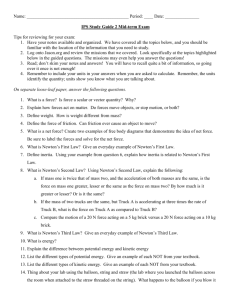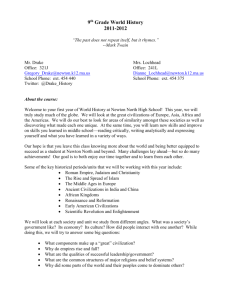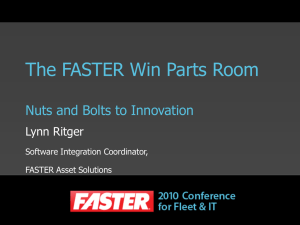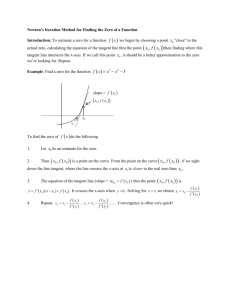Newton`s Discovery stations
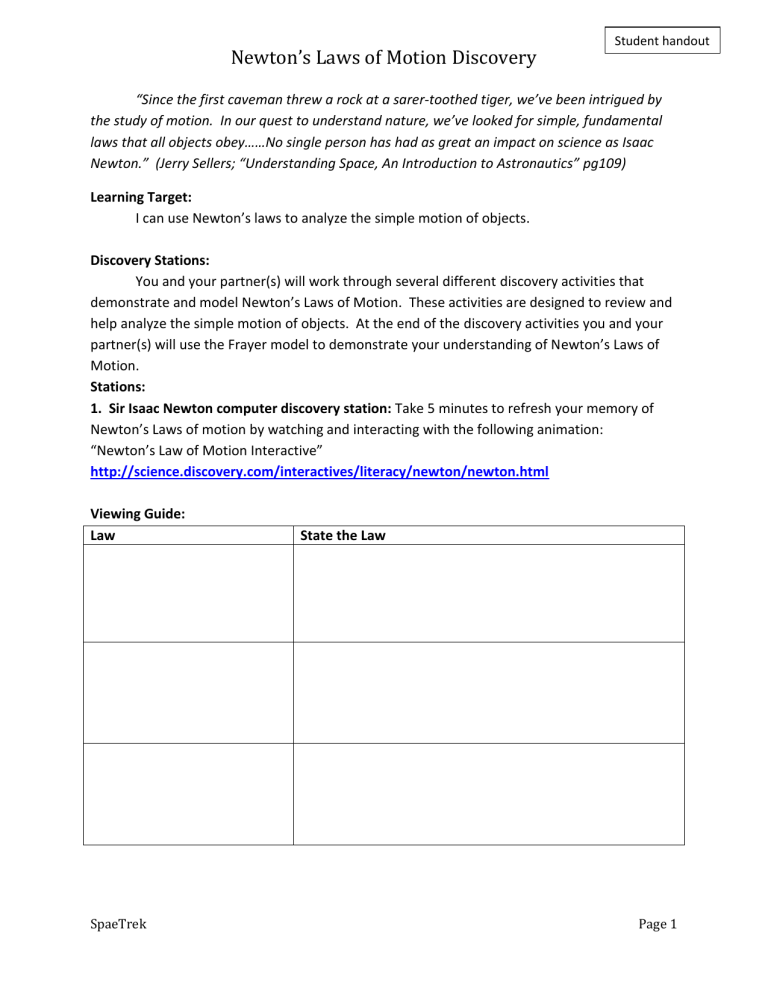
Student handout
Newton’s Laws of Motion Discovery
“Since the first caveman threw a rock at a sarer-toothed tiger, we’ve been intrigued by the study of motion. In our quest to understand nature, we’ve looked for simple, fundamental laws that all objects obey……No single person has had as great an impact on science as Isaac
Newton.” (Jerry Sellers; “Understanding Space, An Introduction to Astronautics” pg109)
Learning Target:
I can use Newton’s laws to analyze the simple motion of objects.
Discovery Stations:
You and your partner(s) will work through several different discovery activities that demonstrate and model Newton’s Laws of Motion. These activities are designed to review and help analyze the simple motion of objects. At the end of the discovery activities you and your partner(s) will use the Frayer model to demonstrate your understanding of Newton’s Laws of
Motion.
Stations:
1. Sir Isaac Newton computer discovery station: Take 5 minutes to refresh your memory of
Newton’s Laws of motion by watching and interacting with the following animation:
“Newton’s Law of Motion Interactive” http://science.discovery.com/interactives/literacy/newton/newton.html
Viewing Guide:
Law State the Law
SpaeTrek Page 1
Newton’s Laws of Motion Discovery
Student handout
Newton's Laws – Ball Drop Laboratory
Purpose: This laboratory will demonstrate Newton’s Laws of Motion.
Materials:
Clay Ruler Baseball Tennis Ball
Pool Ball
Procedure:
Ping Pong Ball Balance Tape
1. Go to a location in the room next to a wall.
2. Place a piece of tape 1 meter above the floor. (This will be the point you release the balls from during the laboratory).
3. Take the mass of each of the balls using a balance and place these masses in the observation table provided.
4. Roll up the clay into a ball and place the ball of clay on the floor under the piece of tape. Place a piece of tape to mark the top of the clay. The set-up should be similar to the diagram below:
5. Drop each of the balls from the 1 –meter mark so that they land on the clay. Using the taped mark just above the clay, measure how much each ball dents the clay. Place that amount in the observation table provided.
6. During this laboratory, think about how you are observing Newton’s Three Laws of Motion.
Observation Table:
Type of Ball
Ping Pong Ball
Mass of Ball (gm)
Tennis Ball
Baseball
Pool Ball
Depth of dent in clay due to the force of the ball (cm)
Conclusion Questions:
1. Describe one way you observed Newton’s First Law of Motion during this laboratory.
2. Newton’s Second Law of Motion explains the relationship between mass, force and acceleration.
In this experiment acceleration due to gravity was the same for each ball. What was the relationship between FORCE and MASS when acceleration was held constant?
3. Describe one way you observed Newton’s Third Law of Motion during this laboratory.
( Adapted and modified form Mrs. Down’s Classroom http://www.cmdowns.com/introduction.htm)
SpaeTrek Page 2
Newton’s Laws of Motion Discovery Student handout
Newton’s First Law of Motion Discovery Stations
Discovery Station: Wacky Washers
1.
To prepare for this experiment, stack 4 washers one on top of the other so that you form a tower of washers.
2.
Place the stack of washers on top of your textbook or on the floor so that you have a smooth, slick surface.
3.
Aim one washer at the bottom of the stack of four washers and give it a good hard flick with your finger or hand. What happens?
4.
Flick a stack of two washers into a stack of four washers. What happens?
5.
Flick a stack of four washers into a stack of four washers. What happens?
6. Explain your observations in terms of Newton’s 1st Law . Draw and label a diagram using arrows in your explanation.
Discovery Station: Magician’s Trick
Note card or playing card
Glass or cup
Some coins (pennies will work) cup card coins
1.
Place the card on top of the glass. Make sure there is enough space to give one edge of the card a good flick without smacking your finger on the glass/cup.
2.
Place a single coin on top of the card so that it rests over the cup's opening.
3.
Flick an exposed edge of the note card. Don't flick the card from underneath. Flick directly from the side of the card's edge.
4.
Observe what happens to the coin. Explain what happened.
5.
Repeat steps 1-4, add pennies to each trial, explain what happens when pennies are added.
6.
How does this activity relate to the “pull the tablecloth” trick used by magicians?
7.
How does this activity relate to Newton’s 1 st Law?
Options to try with your pennies: (if time permits)
Discovery Station: Quarter Catch
Materials = 1-4 quarters
Procedure = *Practice this first to determine how many quarters you are comfortable using*
1.
Bend your elbow and place your hand at your ear, so that your forearm is perpendicular to your face.
2.
Stack the quarter(s) on the flat portion of your elbow.
3.
Throw your arm forward slowly and try to catch the coins with the same hand.
4.
Repeat, this time moving your arm quickly enough to catch the coins.
5.
Compare the results from the slow and fast trial.
6.
Explain how this relates to Newton's First Law.
SpaeTrek Page 3
Newton’s Laws of Motion Discovery Student handout
Student Data Sheet: In the spaces below answer the questions in each lab. Use the space to take notes. Create tables to record your observations and/or data. If needed sketch diagrams.
Magician’s Trick
Prediction:
Wacky Washers:
Prediction:
SpaeTrek Page 4
Newton’s Laws of Motion Discovery Student handout
State the Law:
Frayer Model
State the Newton’s 1 st Law of Motion
List key vocabulary
Newton’s First Law of Motion
Draw a diagram that demonstrates the law.
SpaeTrek Page 5
Newton’s Laws of Motion Discovery
Newton’s Second Law of Motion
Discovery Station: Newton’s Race
Prediction: How does increasing mass (adding more washers) affect the force of objects in motion (the distance the vehicle rolls)?(put prediction on data sheet)
Step 1: Set up a ramp using meter sticks and several books. Place one end of the ramp on the books and line up the other end with a piece of blue painters tape on the floor.
Step 2: Place the vehicle at the top of your meterstick and roll it down the ramp. Use a meter stick to measure how far the vehicle rolls. Repeat this step for Trials 2 & 3.
Step 3: Add weights to the vehicle and repeat the process from Step 2. Record your measurements in the chart. Be sure all the washers remain on the vehicle! Repeat this step for
Trials 2 & 3.
Questions:
1. How does increasing mass (adding more washers) affect the force of objects in motion (the distance the vehicle rolls)? Explain your answer using data from the chart.
2. What would happen if you added weights to the car? Predict how far the car would roll.
3. Explain the results of your experiment in terms of Newton’s 2nd Law.
Options and extensions to Lab: (If time permits)
Option 1
1. Make marks at distances of 0, .50, 1.0, and 2.0 meters on the ground.
2. Station the observer with the stopwatch at a distance of approximately 2 meters.
3. Place a mass on the flat bed car. Begin with the lowest mass and increase the mass that is added to the car for each trial.
4. Allow the loaded car to roll down the ramp.
5. Record the distance that the car travels and the time.
6. Repeat the trials, again recording the data.
Option 2
What would happen to acceleration if the ramp were made steeper?
1. What setup would you use to show this?
2. What is the value of a when the ramp is vertical?
3. Graph the distance and time for each trial.
SpaeTrek Page 6
Newton’s Laws of Motion Discovery
Student Data sheet
: In the spaces below answer the questions in each lab. Use the space to take notes. Create tables to record your observations and/or data. If needed sketch diagrams
Discovery station: Newton’s Race:
Prediction:
Create a data table:
Questions:
Optional Activities (if time permits or use pace for extra notes)
SpaeTrek Page 7
Newton’s Laws of Motion Discovery
Frayer model
State the Law and any other important facts, equations, or information
List key vocabulary that helps describe the law.
Newton’s Second
Law of Motion
Draw a diagram to demonstrate the law.
Describe a real world example of the law.
SpaeTrek Page 8
Newton’s Laws of Motion Discovery
Newton’s Third Law of Motion
Discovery Station: Newton’s Cradle
Prediction: Predict what would happen when one ball is pulled away from the rest of the balls and allowed to swing down to collide with the other balls.
Procedures:
1. Acquire a Newton’s cradle. Place the cradle on a tabletop.
If the balls are moving, stop them or wait for them to stop.
2. Using the thumb and index finger, grab a ball on the end and pull it away from the rest of the balls. Release the ball
3. Explain what happened?
4. Repeat step 2 with different combinations.
5. Record your observations.
6 Explain how Newton’s Cradle demonstrates Newton’s Third Law of Motion.
Discover Station: Penny Slide
Prediction: If two pennies collide with a group of 3 pennies as in the diagram below, predict the result of the collision.
Procedures:
1. Obtain 5 coins (pennies, washers, checkers, etc. will also work)
2. Line up 3 pennies touching in a perfect line.
3. Line up 2 more pennies touching each other in perfect line with the other 3 pennies. There should be a 5 cm gap between the groups of pennies.
4. Place your fingers onto the two slider pennies. Slide the two pennies into the group of 3 pennies. Be sure that the two slider pennies stay in contact with each other when they collide with the group of 3. This may take practice to slide them correctly.
5. Record what happens to the groups of pennies after collision. (repeat several times for best results.)
6. Repeat the collision several more times with different combinations of sliders.
7. Record your observations.
SpaeTrek Page 9
Newton’s Laws of Motion Discovery
Discovery Station: Balloon Races
1. Let's have a balloon race.
2. Materials = a balloon, a plastic straw, some tape and a 10 meter length of fishing line.
3. The purpose is to figure out how to shoot the balloon a distance, using the fishing line as a track for the balloon to follow.
5. The fishing line will be attached to a point at one end of the track. The other end may be held in a team member's hand so that the line is taut throughout the flight. The line may not be moved up and down to help the balloon move toward the end of the track.
6. After blowing up the balloon and pinching off the mouth, the straw should be taped to the balloon.
7. Still holding the balloon closed, the fishing line should be threaded through the straw.
8. Upon releasing the balloon it should take off up the fishing line toward the target.
Questions:
Explain how this activity demonstrates Newton’s Third Law.
You can let your balloon balance on top of balloon the fishing line or below the fishing line.
You choose. tape
You
Fishing line straw
SpaeTrek Page 10
Newton’s Laws of Motion Discovery
Student Data Sheet: In the spaces below answer the questions in each lab. Use the space to take notes. Create tables to record your observations and/or data. If needed sketch diagrams.
Discovery Station: Newton’s Cradle
Discovery Station: Coin Slide
Discovery Station: Balloon Race
SpaeTrek Page 11
Frayer Model
State the Law
Newton’s Laws of Motion Discovery
Key vocabulary and/or characteristics
Newton’s Third Law of
Motion
Draw a diagram to model the law. Explain a real world example of the law.
SpaeTrek Page 12


